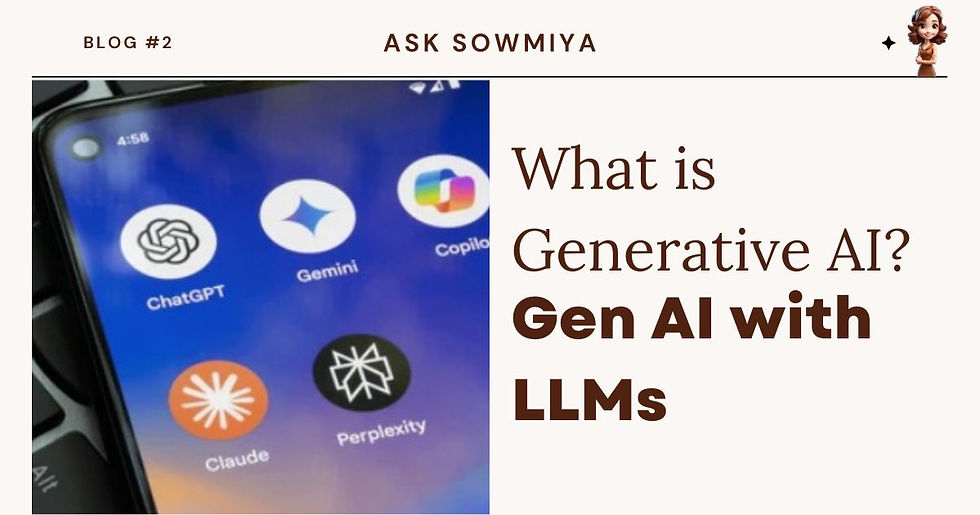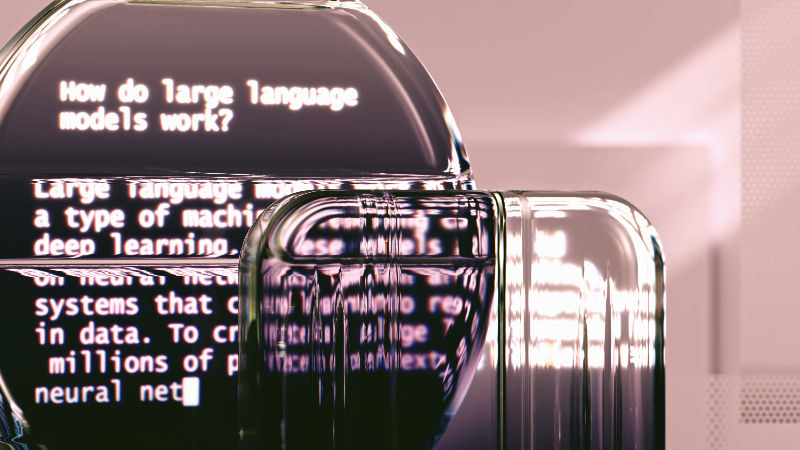What is Generative AI? Understanding Gen AI with LLMs
- Ask Sowmiya

- Mar 16
- 5 min read

In recent years, the field of artificial intelligence has witnessed a revolutionary advancement with the emergence of Generative AI. This cutting-edge technology has captured the imagination of researchers, businesses, and the general public alike, promising to transform various industries and reshape the way we interact with machines.
In this blog post, we'll explore the world of what is Generative AI, exploring its definition, mechanisms, applications, and the crucial role played by Large Language Models (LLMs) in this exciting domain.
Understanding Generative AI vs LLM
To grasp the full scope of these technologies, it's crucial to understand the relationship between Generative AI and LLMs, as well as their distinct characteristics and capabilities.
What is Generative AI?
Generative AI refers to a broad category of artificial intelligence systems designed to create new, original content based on patterns learned from existing data. This technology encompasses a wide range of content generation capabilities, including text, images, music, and more. Generative AI models utilise various techniques such as Generative Adversarial Networks (GANs) and Variational Autoencoders (VAEs) to produce diverse outputs.
The Mechanism Behind Generative AI
At the core of Generative AI lies complex neural network architectures, particularly transformer models, which allow these systems to process and generate content by analysing vast amounts of data.
One of the key features of Generative AI models is their use of self-attention mechanisms. These mechanisms allow the model to focus on different parts of the input data to generate coherent and contextually relevant outputs. This capability is crucial for producing human-like text, realistic images, or other forms of content that require a deep understanding of context and relationships within the data.
What is LLM?
Large Language Models (LLMs) are a specific subset of Generative AI that focuses on processing and generating human-like text. These sophisticated models are trained on enormous volumes of textual data, enabling them to understand and generate coherent, contextually relevant language.

The Role of Large Language Models (LLMs) in Generative AI
Large Language Models (LLMs) play a pivotal role in Generative AI, serving as the backbone for many of its applications. LLMs are advanced AI models designed to understand and generate human-like text. They are built on deep learning architectures that allow them to process and generate text by analysing vast amounts of data.
Difference between Generative AI and Large Language Model
While LLMs are a subset of Generative AI, there are several key differences between the broader concept of Generative AI and the specific implementation of Large Language Models:
Difference | Generative AI | Large Language Models (LLMs) |
|---|---|---|
Scope and Functionality | Encompasses a wide range of content generation capabilities, including visual and auditory content | Specialise in language-related tasks |
Core Technologies | Utilises technologies like GANs and VAEs, designed to mimic the distribution of input data across various modalities | Rely primarily on transformer models optimised for language processing |
Data Usage | May require diverse datasets for different types of content generation, such as images and music | Trained exclusively on text data, requiring large volumes of high-quality textual information |
Applications | Broad applications across industries, including creative fields and scientific research | Particularly suited for language-related tasks such as content creation, translation, and conversational AI |
Ethical and Practical Challenges | Faces issues like the creation of deep fakes and copyright infringement due to its ability to generate realistic media | Poses risks related to misinformation, academic dishonesty, and data bias in textual content |
Applications of Generative AI & LLMs
The versatility of Generative AI and the specialised capabilities of LLMs have led to a wide range of applications across various sectors, driving innovation and efficiency.
Applications in Generative AI
Generative AI is being utilised in numerous fields, showcasing its transformative potential:
Healthcare: Generative AI is revolutionising drug discovery and personalised medicine. It aids in generating new molecular structures and simulating their interactions, accelerating the drug development process.
Manufacturing: In the manufacturing sector, Generative AI is optimising design processes and improving production efficiency. It can generate innovative product designs that meet specific criteria
Creative Industries: Generative AI is transforming the creative industry by assisting in the creation of artwork, music, and video content.
Finance: In the financial sector, Generative AI is used for market trend analysis and strategic content creation, helping institutions make data-driven decisions and communicate effectively with stakeholders.
Applications in LLMs
Large Language Models have found specific applications that leverage their advanced language processing capabilities:
Customer Service: LLMs power sophisticated chatbots and virtual assistants that can engage in natural language conversations, providing 24/7 customer support and enhancing user experiences across various industries.
Content Creation: LLMs assist in writing and editing tasks, generating high-quality written content for articles, marketing copy, and social media posts. They can adapt to different writing styles and tones, making them versatile tools for content creators.
Education: In the education sector, LLMs are used to create intelligent tutoring systems that offer personalied feedback to students and adapt to different learning styles.
Legal Industry: LLMs streamline document review and contract analysis processes in the legal sector. They can quickly scan large volumes of legal texts, identify important clauses, and flag potential risks, significantly reducing the time and resources required for these tasks.
Healthcare: In healthcare, LLMs assist in clinical diagnoses by transcribing doctor-patient interactions into structured records and providing quick access to relevant medical information.
The Future of Generative AI & LLM
Generative AI and LLMs represent a significant leap forward in artificial intelligence, offering powerful tools for content creation, language processing, and problem-solving across various domains.
The future of Generative AI and LLMs is not just about technological advancement, but also about shaping a world where AI enhances human capabilities while respecting our values and societal norms.
If you are looking to establish your domain in Gen AI / LLM through online technical writing, Reach me out through Linkedin & let’s catch up over a coffee :)
Share your thoughts on Asksowmiya as well!
Frequently Asked Questions (FAQs) - What is Generative AI
1. What is Generative AI?
Generative AI refers to a broad category of AI systems that can create new, original content based on patterns learned from existing data.
2. What is the difference between Generative AI and Large Language Models (LLMs)?
While LLMs are a subset of Generative AI, they specialise in language-related tasks, whereas Generative AI encompasses a wider range of content generation capabilities, including visual and auditory content.
3. What is the role of Large Language Models (LLMs) in Generative AI?
LLMs serve as the backbone for many Generative AI applications, as they are advanced AI models designed to understand and generate human-like text.
4. What are some of the core technologies used in Generative AI?
Generative AI utilizes techniques such as Generative Adversarial Networks (GANs) and Variational Autoencoders (VAEs) to produce diverse outputs.
5. What are some of the applications of Generative AI?
Generative AI is being used in healthcare, manufacturing, creative industries, and finance, among other sectors.

Comments